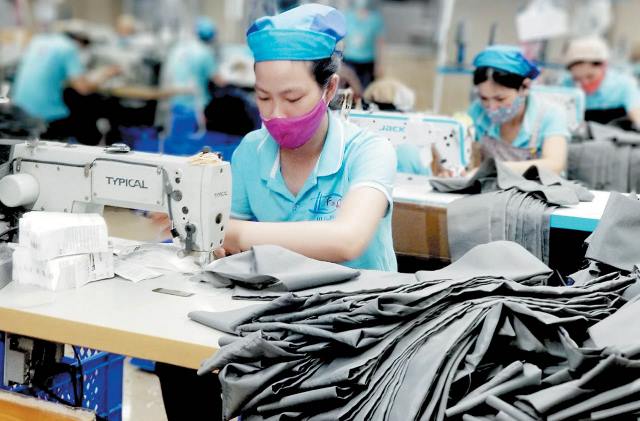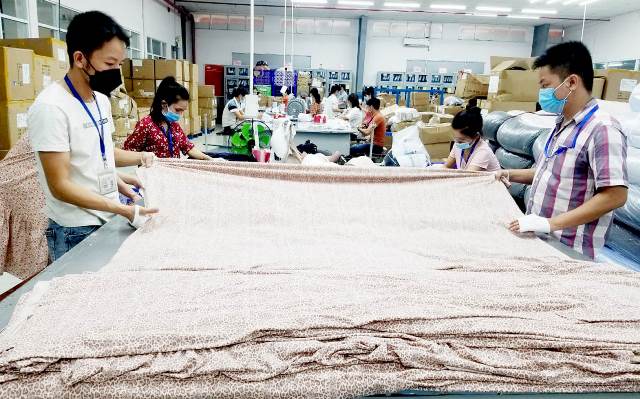
Hue Leather and Footwear Joint Stock Company invests in modern equipment to meet their partners’ orders while it also increases productivity and reduces employees
Orders for 2022 have been signed
Being an enterprise specializing in producing export products for IKEA Group (Sweden) – the huge group specializing in providing household products for customers all over the world – the two garment factories of Hue Leather and Footwear Joint Stock Company always have a stable source of goods and an abundant number of orders.
With over 600 workers working at 2 factories located in Tu Ha and Huong So industrial clusters, to meet the supply for partners, the enterprise has to put their capacity in full and invest in more modern machines to increase productivity.
Director of the company – Mr. Nguyen Xuan Tinh said that stepping to the third quarter of 2021 when the garment factories in Binh Duong, Ho Chi Minh City, and southern cities cannot fulfil the orders signed with their partners due to the contemporary close for COVID-19 prevention, IKEA Group shifted and signed additional new orders with the factories in the provinces and cities that suffering less impact of the COVID-19 pandemic, including Thua Thien Hue. Therefore, at present, the number of orders is quite large, which is double compared to the same period of 2020. Although 2021 is not over yet, the orders for 2022 have already been signed.
According to Mr. Tinh, to meet the demand of orders for their partners, as well as promote product quality and reduce employees, the enterprise invested in automatic sewing machines, at the same time provided vocational training for workers to expand production scale and develop more export industries.
At Scavi Hue, with an increase of 20% - 30% compared to the period of 2020 and about 40% compared to the first quarter of 2021, at present, the enterprise has already had orders to the middle of 2022, 4 factories are in operation at full capacity to ensure deliveries on time.

Producing textile and garment products for export at Scavi Hue
According to General Director of Scavi Hue - Mr. Tran Van My, in order to meet the demand on increasing goods for export partners in the context of continuously increasing orders, and, at the same time sharing difficulties for garment factories in Binh Duong, Ho Chi Minh City, which are closed and/or decrease the number of goods due to the impacts of the pandemic, Scavi Hue is running the investment in constructing another factory with the scale of 2.000 employees and cost of 150 billion VND.
At the same time, they are developing a trade zone, logistics services for the textile and garment industry, striving to bring export turnover in 2021 to 350 million USD, at the increase of 40% compared to 2020.
Currently, the company is announcing the recruitment of 2,000 more employees to better the resources for factories, in which priority is given to workers returning from pandemic areas; and, there are many preferential policies for skilled workers who used to work at garment factories in the southern provinces.
Investing in equipment, and developing supply chain
After difficulties in orders and product output, in the last months of 2021, many textile and garment enterprises are returning to production when they receive many orders, as the supply of raw materials is stable, they reach many advantages in production.
According to the leader of Hue Textile and Garment Joint Stock Company, the production and business situation of its in the first 9 months of 2021 has changed positively. Consumption revenue increased sharply, an increase of 40% compared to the same period in 2020.
To meet the orders, the company's factories have well implemented solutions to increase labor productivity, the processing revenue of each factory reaches 12 billion VND/month, the highest ever. The average labor productivity is over 25 USD/person/day.
At present, the company has negotiated and signed orders until the end of the fourth quarter of 2021 and is continuing to receive orders in 2022 from big customers such as Kohl's, Target, Perry Ellis, etc.
According to the Department of Industry and Trade, the export turnover of goods in September 2021 reached 103.8 million USD, bringing the total export turnover of the first 9 months of 2021 to 840.3 million USD, at the increase of 32.2% compared to the same period, and reaches 91. 3% of the annual plan.
In which, processed products reached 633 million USD, at the increase of 25.5% and accounted for 75.4% of the total export turnover, including: kinds of fiber and textile yarns were estimated at 203 million USD, an increase of 62.0%; garments were estimated at 368 million USD, an increase of 12.7%.
Although orders have increased again, but the strong products of textile and garment enterprises at local such as suits and shirts have not yet been recovered because many countries are still affected by the pandemic, people are restricted to go out. Those enterprises mainly produce items such as underwear, pajamas, warm clothes, medical protective equipment, masks, etc., so they have to invest in tools and mechanical systems to meet the new orders.
According to textile and garment enterprises, the current urgent issue is fearless of innovating the engineering process, properly combing the existing engineering abilities and investing in the procurement of synchronous and high-tech qualified textile equipment, gradually eliminating obsolete engineering equipment.
Director of Phu Hoa An Textile Garment Joint Stock Company - Mr. Le Hong Long said that textiles and garments are characterized by high flexibility in the market, short lifecycle, high "trendiness" and internationality. Therefore, the technology must be innovated quickly and in the direction of modernity.
According to the leader of The Department of Industry and Trade, the textile and garment enterprises all over the world are moving their production to Vietnam day after day. They need to strengthen the cooperation with large distribution and retail groups in the world in order to stabilize their customers and gradually participate in their supply chains. These are also in the supply chains between the manufacturers, suppliers of raw materials and the system of goods consumers.
The Department will take advantage of industrial promotion funds to support enterprises with a part of equipment investment costs, vocational training, and, at the same time disseminate the information relating to import-export so that enterprises can reach the necessary information, etc.
Story and photos: Thanh Huong